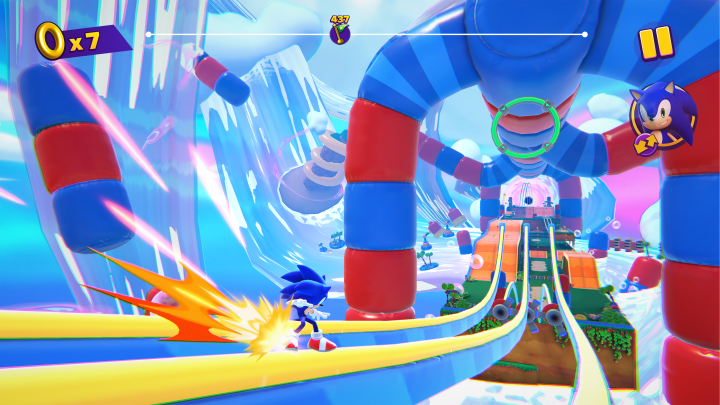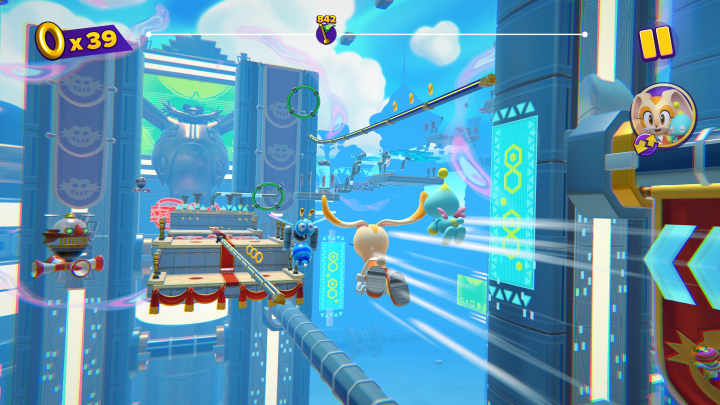Love it or hate it, you have to respect the Sonic the Hedgehog series. Sega and Sonic Team refuse to get stuck in a creative rut, constantly zigging when fans expect them to zag. Last year, the series took an unexpected open-zone pivot with Sonic Frontiers, only to return to familiar 2D platforming with this year’s Sonic Superstars. Just one month after that game’s release, the blue blur is taking another surprising turn with Sonic Dream Team.
Launching exclusively for Apple Arcade on December 5, Sonic Dream Team sees the series returning to the 3D roller-coaster design of the Sonic Adventures era. It’s both a nostalgic return to form and something entirely new, making for the most ambitious Sonic mobile game yet. It’s not the project I’d imagine anyone was expecting, but it might just be the one that fans have been waiting for.
I went hands-on with Sonic Dream Team at an Apple showcase event, playing both on an iPad with touch controls and on a TV with a controller. The project properly replicates the feeling of Sonic’s early 2000s adventures with fluid, snappy races through levels with multiple paths. That might give Apple Arcade another secret weapon, as it’s already shaping up to be one of the more fun Sonic experiences since 2017’s Sonic Mania.
Rolling around
Sonic Dream Team is a 3D adventure where Sonic and his pals zip through winding levels with several pathways. The amusement park gameplay is familiar, with characters homing in on enemies and objects with the press of a button and fluidly jumping between obstacles. Developer Sega Hardlight gets the formula exactly right by strongly magnetizing characters to objects. When I jump between rails, I don’t have to worry that I’m going to overshoot. Movement largely feels consistent, and it’s where the studio’s experience with making tight infinite runners is most apparent.

Structurally, Dream Team bears a surprising resemblance to classic 3D Mario games. When I select a level, I actually get a row of different missions that have me completing various objectives in that stage. In one level, I simply have to get to the end as leisurely as I choose. Another variant has me racing through checkpoints as fast as I can, while a third has me collecting keys hidden throughout the stage. Each grants me an orb, which are used to unlock new stages, just like stars in Super Mario 64. A developer I spoke to at the event referenced Super Mario Sunshine as an inspiration and that very much shows (he also name checked Tony Hawk’s Pro Skater, which is surprisingly apparent too).
Levels are meant to be replayed in Dream Team and that’s accomplished in a few ways. For one, there are multiple paths to explore in any given level. I start one by sticking to the right and bouncing off some bumpers. Next time I jump in, I run over to the right lane and use my homing attack to bounce up some enemies and springs to get a hidden collectible (each level has five red stars and a handful of hidden blue coins). I can also hold down a dash button to get a boost forward, which allows me to run up walls and access secret areas.

The big draw, though, is that there are six playable characters — and that’s not just cosmetic. Sonic and Amy are your standard hedgehogs, while Knuckles and Rouge the Bat can glide and climb up walls. Tails and Cream, on the other hand, can use their helicopter tails to reach high areas. Levels are designed with pathways specific to those different abilities. In one level, I find a wall that I’m unable to climb as Sonic. I load back in as Knuckles and suddenly I’m taking an entirely different path through the stage, which has me gliding between walls. Usually I’d move on from a level to see something new in a demo like this, but I found myself replaying stages several times and making new discoveries with each attempt.
There are some movement hitches to that approach. Every character still has the same baseline speed and momentum, but their exclusive paths don’t always account for that. One Knuckles segment had me trying to hop around small platforms in midair, which can be difficult to nail down when the character hits a running speed so fast. Even so, movement mostly felt fast and smooth for me during my demo, especially on mobile, where its minimal touch controls do it all justice.

More than anything, though, Sonic Dream Team simply has the right attitude. It sports a cheery visual design with soft textures and bright colors. Levels look almost like bouncy castles, which gives it all an inviting, playful appearance. Despite being built for mobile devices, it might be the best-looking 3D Sonic game yet — at least in terms of its cohesive art direction.
As someone who has found recent Sonic games hit and (sometimes very) miss, Sonic Dream Team has my attention. The levels I played were breezy fun that took me back to my time with games like Sonic Adventure 2 Battle on GameCube. That formula has been smoothed out by a development team that’s very familiar with how to make snappy mobile games. If later, more challenging levels can still retain this level of fluidity and not give way to fiddly frustration, Sonic fans may have a very good reason to sign up for Apple Arcade soon.
Sonic Dream Team launches on December 5 on iOS devices via Apple Arcade.



